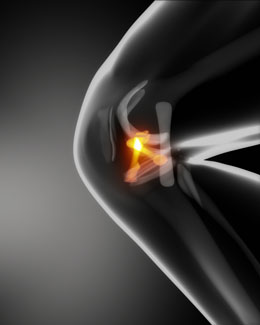Athletes are susceptible to knee injuries, and could get affected by pain in the front section of the knee. Knee pain could also be experienced by people affected by a degenerative joint disease. This article provides some information about the causes, symptoms, and treatment of anterior knee pain.

Knee pain can be felt in the lateral, anterior, posterior, or medial section of the knee. Anterior knee pain refers to the pain experienced in the front section of the knee. Also known as runner's knee, it should be addressed at the earliest, by a trusted physician for quick recovery. However, the failure to do so would worsen the condition and adversely affect the range of motion of the joint. The treatment would involve proper rest, application of heating pads/ice packs, application of crepe bandage, the use of anti-inflammatory drugs, etc. Physiotherapy might also prove beneficial.
Causes and Symptoms
Anterior knee pain syndrome is a medical condition that commonly affects sportspersons. An individual affected by this syndrome will experience pain in and around the kneecap after walking on slopes (either uphill or downhill), sitting for a long time, and while jogging. The actual cause of this knee problem is not known. However, the medical practitioners are of the opinion that this syndrome is triggered by joint overuse, weakened muscles, flat feet, obesity, and increased intensity of exercises.
The main causes are inflammation of the tendons in the knee area (called tendinitis) and pulled muscles (especially hamstrings and quadriceps). In case of sportspersons, the major causes are patellar tendinopathy and patellofemoral syndrome. While the former is triggered by jumping and landing activities, the latter is related to running downhill and long distance running. Also, this pain is a notable sign of dislocated kneecap, physical trauma to kneecap, and arthritis.
The alternative name 'runner's knee' reveals that this condition occurs frequently amongst runners. In the initial stages, pain in the anterior knee is felt while running down a slope. One is likely to experience pain while walking or jogging, if the condition is left untreated. The noticeable symptoms are swelling, popping (or alike sound), and tenderness of the affected area. The affected people often experience an exacerbated pain behind the kneecap when bending and after prolonged sitting. At times, a sharp pain occurs while standing, due to which a person would stumble or fall down.
Treatment
Taking rest is an integral part of the treatment. This allows the affected tissues to heal and recover. Deep knee bending and performing any physical activities that would involve the knee joint is strictly not recommended. In order to obtain instant relief, one can apply ice packs. It also aids in reducing the swelling and inflammation. However, if the pain persists, or worsens even after resting the knee joint, consult a doctor as soon as possible.
The syndrome and/or runner's knee is difficult to diagnose. In order to determine the exact location of the pain, the orthopedics would examine the physical symptoms and assess the intensity of pain. Also, for the identification of any structural damage, imaging tests of the affected knee, like joint X-ray, CT (computed tomography) scan, and MRI (magnetic resonance imaging) scan would be performed. After confirmation, the doctor would recommend the use of painkillers and anti-inflammatory drugs. Following some mild strength exercises will also help.
Based on the extent of tissue damage, the orthopedic doctor will suggest the application of a compression bandage, and certain exercises to quicken the recovery time. Basically, stretching movements and strengthening knee exercises, form the base activities for improving the affected knee. In nearly all the cases, surgery is rarely performed, and is not necessary for treating pain behind the kneecap. Following certain self-care tips might prove beneficial to the affected people.
The affected person should refrain from performing regular exercises or sport activities, until the affected knee recovers fully. In order to prevent the onset of this condition, one must follow the right technique and form while exercising. A warm-up session is a must before high intensity exercises, and the strengthening exercises should be followed by stretching and cooling down exercises.
Disclaimer:
This Buzzle article is for informative purposes only, and should not be used as a replacement for expert medical advice.


 Knee pain can be felt in the lateral, anterior, posterior, or medial section of the knee. Anterior knee pain refers to the pain experienced in the front section of the knee. Also known as runner's knee, it should be addressed at the earliest, by a trusted physician for quick recovery. However, the failure to do so would worsen the condition and adversely affect the range of motion of the joint. The treatment would involve proper rest, application of heating pads/ice packs, application of crepe bandage, the use of anti-inflammatory drugs, etc. Physiotherapy might also prove beneficial.
Knee pain can be felt in the lateral, anterior, posterior, or medial section of the knee. Anterior knee pain refers to the pain experienced in the front section of the knee. Also known as runner's knee, it should be addressed at the earliest, by a trusted physician for quick recovery. However, the failure to do so would worsen the condition and adversely affect the range of motion of the joint. The treatment would involve proper rest, application of heating pads/ice packs, application of crepe bandage, the use of anti-inflammatory drugs, etc. Physiotherapy might also prove beneficial.